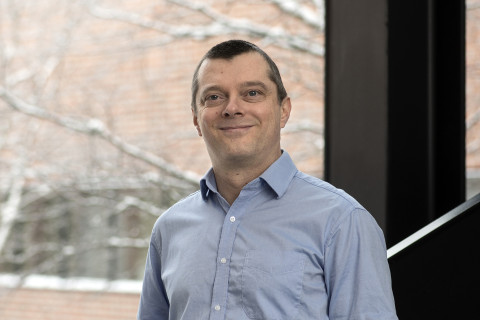Students are the key to a bright future for photonics
“Theoretical and simulation studies must be feasible and linkable to experiments,” says the newly appointed Professor of Experimental Photonics Matthieu Roussey.
Matthieu Roussey studied physics and chemistry at in Besançon at the University of Franche-Comté, and defended his PhD on tunable lithium niobate photonic crystals in 2007. He worked for four years at École Polytechnique Fédérale de Lausanne, where he led the Nanophotonics group in Neuchâtel, Switzerland.
Roussey was appointed as an Associate Professor (Tenure Track) in Experimental Photonics in 2016. He currently leads the university’s Integrated Optics Group. He is also a member of the Board of Directors of the European Optical Society and a member of the Editorial Board of the Journal of European Optical Society.
“I chose experimental photonics because I’m an experimentalist. Even if I do also some theoretical and simulation studies, they must be feasible and linked to experiments.”
“Experimental photonics is a broad domain that enables applications of optics and photonics in real life. One of my goals is to make photonics useful for the broadest community with both societal and scientific impact.”
“I would like to see more interaction between the different fields of science, with collaborations between our Institute of Photonics and the other departments at UEF and abroad.”
“In addition, I’d like to see more devices and real systems useful in everyday life. This can be achieved through commercialisation and industrial projects”.
Photonics is set on a solid foundation made of material science, mathematics, chemistry, and physics, of course.
“In integrated optics, we develop new platforms for future communication systems at low cost and low power consumption.”
“We study particular dielectric surface waves and systems to understand how they can be used in systems like sensors, light sources, detectors, computing schemes, and so on. We are also exploring how these could be used to realise smart sensors able to detect and analyse optically complex liquids or gases for applications in environmental and health science.”
“I’m also interested in research on micro- and nanoplastics and especially their optical detection in water environment. The work was initiated by Kai Peiponen, still very active in this research, which is a global challenge. Now, the work focuses on the realisation of sensors and other devices to screen, monitor, and even remove these particles.”
Roussey points out that photonics is a tool enabling other technologies. Nowadays, photonics is everywhere. The photonics industry is growing, and it is one of the domains that hasn’t suffered much from the COVID-19 pandemic.
“Photonics enables operation at the speed of light. We can already see applications in automotive industry, computer technologies, and in the medical sector not only for diagnosis, but also for cure and surgery. The PREIN Flagship for Photonics Research and Innovation is creating a synergy between research institutions in Finland for the growth of photonics and its applications. It is a great chance to be a part of it and it shows how photonics is crucial for the future.”
“I believe that a field of research is active only if there is teaching activities associated with it. Students are the key to a bright future for photonics, which must be promoted not only in science classrooms, but also in art, medical, literature, business, economy, and all the other schools.”
***
Matthieu Roussey
Matthieu Roussey, Professor of Experimental Photonics, from 1 October 2020 onwards
born 1979, Besançon, France
- PhD 2008, Optics - Engineering technology, University of Franche-Comté, France
Key roles
Project Researcher, University of Eastern Finland, 2011–2016
Project Leader, Associate Researcher, Optics & Photonics Technology Laboratory, École Polytechnique Fédérale de Lausanne (EPFL), Institute of Micro-engineering (IMT), Neuchâtel, Switzerland, 2007–2011



